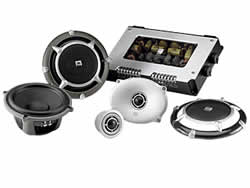JBL 660GTI 2-Way Competition Component Speaker System
JBL Updated: 2008-09-14 RSS
At JBL, we've had more practice than any other speaker company at eliminating distortion, and it shows. GTi competition speaker systems include the lowest-distortion woofers we've ever built. In a loudspeaker, distortion can be produced by the cone, the motor, the suspension and even the movement of air through the speaker's assembly. In designing the 560GTi and 660GTi woofers, JBL engineers have left no stone unturned. The basket, polepiece and voice coil former all include vents to eliminate any potential distortion caused by the movement of air trapped within these parts. The ultrarigid Kevlar® cone eliminates unwanted cone flexing (also called modal distortion), which can cause big peaks and dips in the midrange response. The spider and surround are designed to ensure linear forward and rearward motion, minimizing distortion caused by the speaker's suspension. The motor includes a copper polepiece cap and a flux stabilization ring that work together to produce a linear voice coil inductance that minimizes intermodulation distortion. Finally, an extra-long voice coil ensures that the coil remains in the magnetic gap to minimize distortion at low frequencies and their harmonics, and during high-output transients. The result is crystal-clear midrange, snappy mid-bass without any audible ringing or hang-over, and a smooth frequency response that needs no compensation circuitry in the crossover.
Many speaker systems are designed for on-axis listening and often include a listening window that's ±30° from the speaker's 0° axis. That's great for home audio or other applications where speakers can be easily pointed at a single listener. In a car, however, the possible speaker mounting locations don't always allow for on-axis placement even for a single listener. In many cases, on-axis placement for two listeners simply isn't possible because the mounting locations are too close to the listeners to allow a single 60° window to cover both listeners. GTi competition speaker systems incorporate a 35° design axis, which provides an optimal listening window for each front-seat listener.
Controlling the directivity of the tweeter, waveguides contribute two significant improvements to the performance on the GTi Competition Speaker Systems. Waveguides match the directivity of the tweeter to that of the woofer at the crossover by focusing the tweeter's output into the listening window. Waveguides decrease the directivity of the tweeter at high frequencies through controlled diffraction along the gentle transition from the waveguide's conical center section to the waveguide's outside edge. Both of these contributions ensure that the off-axis response reflected by nearby surfaces more closely resembles the response in the optimal listening window. That makes speakers sound better in any environment.
The crossover included in GTi competition speaker systems is more than a set of simple filters. The filter frequencies, slopes and Q values are carefully chosen to provide a phase-aligned transition between woofer and tweeter with optimally flat frequency response at the design axis and throughout the listening window. Additionally, the tweeter's high-pass filter circuit includes a level control and frequency contour to optimize the system's response when the waveguide is used or when the tweeter is conventionally mounted. Capacitor, inductor and resistor types have been selected to minimize distortion and maximize power handling. Air-core coils minimize saturation, which can cause distortion at high input power. Low-loss, low-ESR polypropylene capacitors provide crystal-clear high frequencies, while wire-wound precision resistors with integral heatsink ensure filter stability at high input power. Finally, for systems that will include a separate amplifier channel for each speaker, the GTi competition system crossover includes bi-amp capability.
SPECIFICATIONS
General
Power Handling, RMS: 150 Watts
Power Handling, Peak: 600 Watts
Frequency Response (±3dB): 50Hz - 30kHz
Sensitivity (2.83V @ 1m): 91dB
Impedance: 4 Ohms
Mounting Depth: 3-1/16" Woofer, 1-5/16" Tweeter
60th Anniversary GTi Speaker Literature
Owners Manual
Related Manuals
JBL 560GTI 2-Way Competition Component Speaker System
JBL C508GTI MKII 2-Way Component Speaker System
JBL C608GTI MKII 2-Way Component Speaker System
JBL GTO507C 2-Way Component System
JBL GTO607C 2-Way Component System
JBL GTO8607C 2-Way Component System
JBL P560C 2-Way Component System
JBL P660C 2-Way Component System
JBL GTO1204BP Band-Pass Enclosure
JBL GTO1204BP-D Preloaded Band-Pass Enclosure
JBL PB1220 Preloaded Enclosure
JBL MS6100 Dual-Cone Marine Speaker